Points to Consider in Choosing a Teapot
We carry a variety of teapots by shape, place of origin and size. We would be happy if you could find the teapot that best suits you.
1. Size
Check each product's capacity as a guide.
A teapot with a capacity of around 300 ml is about two teacups. It is easy to hold and is an ideal size for everyday use.
A teapot with a capacity of around 450 ml is about four teacups. It is perfect for large families and for serving guests.
A small teapot with a capacity of about 150 ml is very small, and is typically used for enjoying "Gyokuro" or tea of the highest quality and other high-grade teas.

2. Tea strainers
There are tea strainers made of stainless steel that can be detached from the teapot. There are teapots that have a lot of holes in their bodies; as well as earthenware pieces with plenty of fine holes attached to teapots which are representative of Tokoname teapots.
A stainless steel tea strainer has the advantages of easily throwing away tea leaves and being easy to clean but it also has its disadvantages. It deteriorates, rusts and gets damaged from long-term use so it needs to be replaced. Moreover, tea in stainless steel strainers can only swirl within the strainer so it is limited when you are pursuing the tea's delicious taste.
You can make even more delicious-tasting tea when you use a teapot equipped with a ceramic tea strainer in its body because the tea leaves swirl and stay all throughout the teapot.
In addition, because it is earthenware, the strainer will not deteriorate or get damaged. However, it is a bit troublesome when throwing the tea leaves away.
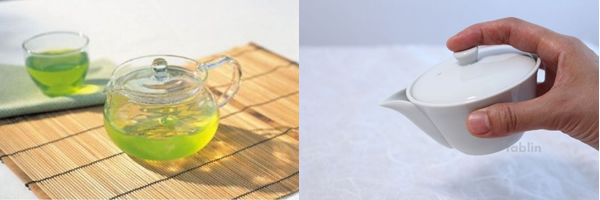
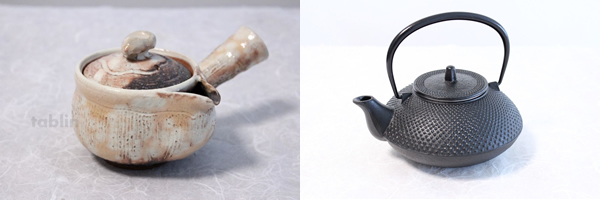
3. Materials
There are different kinds of teapots - earthenware, porcelain, glass, iron and others.
Glass and porcelain teapots are easy to care for, and their bodies do not absorb water so the taste of the tea is not affected.
Earthenware teapots are a little absorbent so it is necessary to dry them well after use.
Moreover, bitter substances such as catechins adhere to the inside of the teapot depending on the quality of the mud, the presence or absence of glaze and its method of firing; resulting in a relative increase in umami-rich tannins that make the tea even more delicious. Also, compared to porcelain and glass teapots, earthenware teapots are light so they are characterized by easy handling.
Other teapots such as iron teapots made of Nambu iron and others have very high heat-retaining properties. Their heft and high sense of design are also appealing.

4. Shape
There are teapots with rod-shaped handles, and there are those with round handles in Western-style teapots.
There are also teapots without handles such as "Hohin" teapots.
Hohin are mostly used in making tea that utilizes warm water such as Gyokuro tea. Hot water isn't needed so the teapot has no handle.
5. Main places of origin and their characteristics
Tokoname
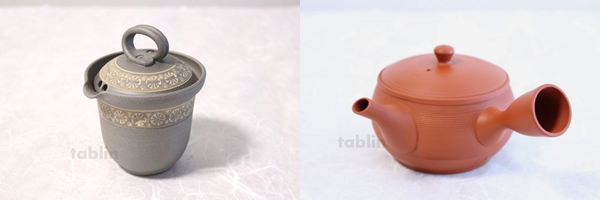
Tokoname is representative of Japan's teapot-making places. With their unique blend of mud and being fired at very high temperatures, Tokoname teapots have a hardness similar to porcelain and at the same time, possess a texture with an earthen-feel.
Each teapot and lid fit perfectly and form a tight seal so unnecessary air does not enter the teapot; resulting in longer-lasting tea and the flavors, scent and color of the tea are drawn out. Also, most Tokoname teapots are unglazed and are equipped with an earthenware strainer with many fine holes, surpassing other teapots in terms of lightness and have the ultimate functionality among Japanese teapots.
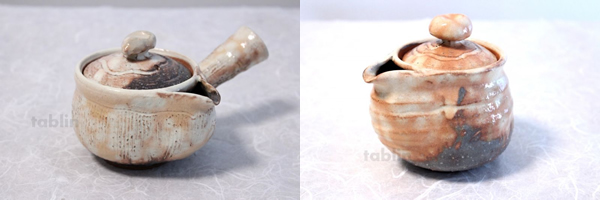
Hagi ware
Part of the clay used in Hagi ware is permeable. With usage, tea permeates fine cracks in the glaze so the color and shine of the interior and the exterior of the teapot subtly changes over time, bringing about an indescribable appearance. Hagi ware come in various types such as teapots, Western-style teapots, Hohin and others.
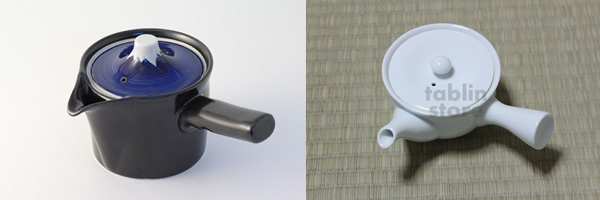
Arita
Comparatively speaking, many of these teapots are made of porcelain and have beautiful drawings and unique shapes. Moreover, large-sized teapots called "Dobin" are made in Arita.
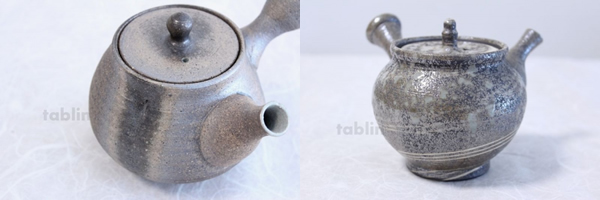
Shigaraki pottery
Shinraku has a unique earthen-feel, and its handmade style is appealing.
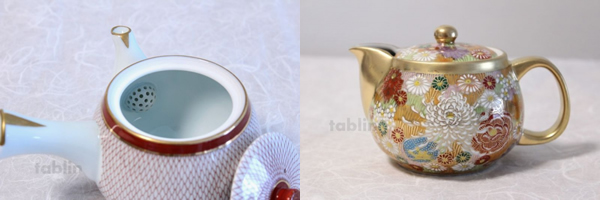
Kutani
Many of these teapots are made of porcelain and are characterized by beautiful drawings such as those found in bowls.
We carry a variety of teapots by shape, place of origin and size. We would be happy if you could find the teapot that best suits you.
1. Size
Check each product's capacity as a guide.
A teapot with a capacity of around 300 ml is about two teacups. It is easy to hold and is an ideal size for everyday use.
A teapot with a capacity of around 450 ml is about four teacups. It is perfect for large families and for serving guests.
A small teapot with a capacity of about 150 ml is very small, and is typically used for enjoying "Gyokuro" or tea of the highest quality and other high-grade teas.

2. Tea strainers
There are tea strainers made of stainless steel that can be detached from the teapot. There are teapots that have a lot of holes in their bodies; as well as earthenware pieces with plenty of fine holes attached to teapots which are representative of Tokoname teapots.
A stainless steel tea strainer has the advantages of easily throwing away tea leaves and being easy to clean but it also has its disadvantages. It deteriorates, rusts and gets damaged from long-term use so it needs to be replaced. Moreover, tea in stainless steel strainers can only swirl within the strainer so it is limited when you are pursuing the tea's delicious taste.
You can make even more delicious-tasting tea when you use a teapot equipped with a ceramic tea strainer in its body because the tea leaves swirl and stay all throughout the teapot.
In addition, because it is earthenware, the strainer will not deteriorate or get damaged. However, it is a bit troublesome when throwing the tea leaves away.


3. Materials
There are different kinds of teapots - earthenware, porcelain, glass, iron and others.
Glass and porcelain teapots are easy to care for, and their bodies do not absorb water so the taste of the tea is not affected.
Earthenware teapots are a little absorbent so it is necessary to dry them well after use.
Moreover, bitter substances such as catechins adhere to the inside of the teapot depending on the quality of the mud, the presence or absence of glaze and its method of firing; resulting in a relative increase in umami-rich tannins that make the tea even more delicious. Also, compared to porcelain and glass teapots, earthenware teapots are light so they are characterized by easy handling.
Other teapots such as iron teapots made of Nambu iron and others have very high heat-retaining properties. Their heft and high sense of design are also appealing.

4. Shape
There are teapots with rod-shaped handles, and there are those with round handles in Western-style teapots.
There are also teapots without handles such as "Hohin" teapots.
Hohin are mostly used in making tea that utilizes warm water such as Gyokuro tea. Hot water isn't needed so the teapot has no handle.
5. Main places of origin and their characteristics
Tokoname

Tokoname is representative of Japan's teapot-making places. With their unique blend of mud and being fired at very high temperatures, Tokoname teapots have a hardness similar to porcelain and at the same time, possess a texture with an earthen-feel.
Each teapot and lid fit perfectly and form a tight seal so unnecessary air does not enter the teapot; resulting in longer-lasting tea and the flavors, scent and color of the tea are drawn out. Also, most Tokoname teapots are unglazed and are equipped with an earthenware strainer with many fine holes, surpassing other teapots in terms of lightness and have the ultimate functionality among Japanese teapots.

Hagi ware
Part of the clay used in Hagi ware is permeable. With usage, tea permeates fine cracks in the glaze so the color and shine of the interior and the exterior of the teapot subtly changes over time, bringing about an indescribable appearance. Hagi ware come in various types such as teapots, Western-style teapots, Hohin and others.

Arita
Comparatively speaking, many of these teapots are made of porcelain and have beautiful drawings and unique shapes. Moreover, large-sized teapots called "Dobin" are made in Arita.

Shigaraki pottery
Shinraku has a unique earthen-feel, and its handmade style is appealing.

Kutani
Many of these teapots are made of porcelain and are characterized by beautiful drawings such as those found in bowls.